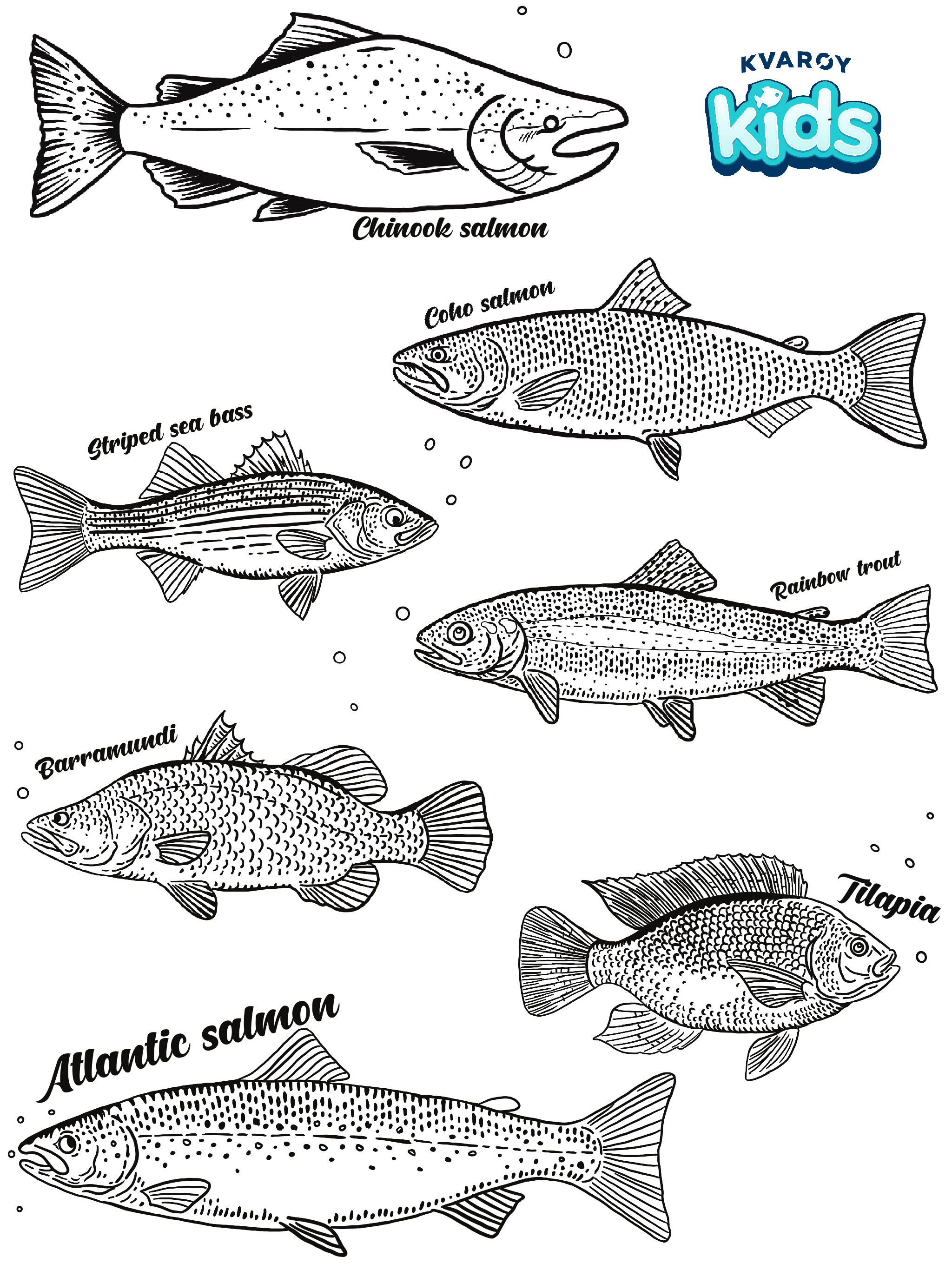The Different Members of the Salmon Family
Salmon is the favorite family of fish for many people around the world! We say “family” because there’s WAY more than one type of salmon swimming in the world’s oceans—from Norway, all the way through Canada, to the east coast of North America. To help you meet this big family of fish, we put together a helpful guide to the different salmon species.
You can find out what they look like, what makes them unique, and how to tell them apart. We also created a free coloring page with the main type of fish that you might have cooked at home or seen at the grocery store — barramundi, striped sea bass, and rainbow trout. You can download it and try to color the different fish according to their specifics.
Before we jump into the details, let’s go through the basics: there are Atlantic and Pacific salmon and they belong to the family Salmonidae. When a family of species has a subcategory, it is called a genus (imagine them as smaller families or subfamilies). Pacific salmon belong to the genus Oncorhynchus while Atlantic salmon are the largest members of the genus Salmon.
There is only one species of Atlantic salmon, and its members are silvery with large, black spots on their gill covers, tail, and back. There are six types of Salmon in North America. Five come from the Pacific coast and are called Pacific Salmon. These are chinook, coho, sockeye, pink, and chum salmon.
Even though they are members of one family, every species of salmon is unique, different, and special. Some of them are tough fighters, while others taste great. Some aren’t good for either of those things, but they make up for it with their outlandish looks. Hopefully, you’ll have an easier time identifying which fish you’re looking at next time you go grocery shopping. If nothing else, you can appreciate how awesome this entire family of fish really is.
As their names suggest, Atlantic salmon are originally from the Atlantic Ocean, while Pacific salmon are from the Pacific Ocean. Atlantic salmon are really different from the other species of their family. For starters, they live on the other side of the North America continent, and are close to the picturesque coastline of Norway. Also, Atlantic salmon are actually more closely related to brown trout than other salmon species.
Even so, they share some things in common. The Atlantic and Pacific are strong predators that like cold water. They normally live in the sea, but they move into freshwater to spawn. When they do, they transform, changing color, even shape.
Chinook salmon are nicknamed “king salmon” because they are the biggest and heaviest of all the world’s salmon, reaching 5 feet long and topping the scales at over 100 pounds. Considered to be one of the best tasting, they have a high fat content and corresponding rich flesh that ranges from white to a deep red color.
Chinook is the most widespread salmon in North America. They show up all the way from the deep Pacific waters of southern California to the ice-cold rivers of northern Alaska.
The easiest way to recognize chinook salmon is by their mouths. Their gums and the entire inside of their mouths are black, hence the nickname “blackmouth salmon.” You can also notice round spots on both the upper and lower halves of their tails and across their backs.
Coho salmon has bright red flesh and silver skin. They don’t grow quite as big as chinook salmon, but fight twice as hard in water and have a similar flavor. They don’t travel quite as far south as chinook either. You mainly start to see them in Oregon, and they become more common once you hit Washington. Like the chinook, the easiest way to recognize coho is by their mouths. They have black mouths like chinook, but their gums are white. They also have spots along their backs, but they only have spots on the top half of their tails.
Atlantic salmon grow almost as big as chinook and are ready to fight as much as coho. The easiest way to recognize them is by their spots. They have large dark spots on their gill covers, and x- or y-shaped spots on their upper body.
As an overview, here are key specifics about each type of salmon:
Chinook salmon is the biggest fish in the salmon family. You can tell it apart by its black mouth with black gums. When it spawns, it turns olive-maroon with distinctive spots all over its tail.
Coho salmon is the hardest fighter and has a black mouth with white gums. When it spawns, it grows a “kype” and turns maroon with a dark back.
Sockeye salmon has bright red-orange flesh and a white mouth with white gums. When it spawns, it turns bright red with a dull-green head and tail.
Pink salmon is light-colored and low in fat content, and it has a white mouth with black gums. When it spawns, it turns grey on top and white below. Males grow a humpback.
Chum salmon has a white mouth with white gums. When it spawns, it turns green with purple stripes. Males grow big teeth.
Atlantic salmon is big and has x- or y-shaped spots. When it spawns, it looks more like a brown trout than other salmon species.







